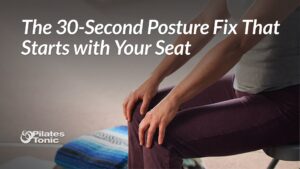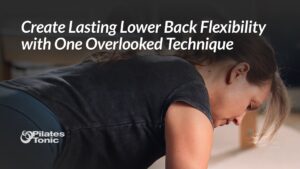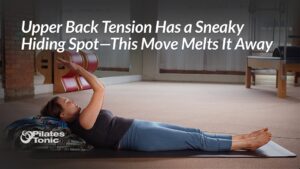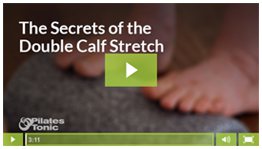The Wall Pec Stretch
Today’s video kicks off a three-video series that is particularly close to my heart, or maybe I should say it's close to my back. 😉
I'll be showing you the key things you need to know about your mid-back connection and, if you study and learn everything I'm going to share with you, I have no doubt you'll avoid a lot of the neck and low-back pain I created for myself before I had a clue what a mid-back connection was.
Don't Hold Your Arms Like I Did!
I worked as a hairstylist for over twenty years and fourteen of them were behind the chair. Unfortunately, I didn't understand what a mid-back connection was until long after I’d hung up my shears and created a lot of pain and chronic problems that I would later spend time fixing with Pilates.
My pain was caused by the way I used my body while doing hair—it turned out I was holding my arms wrong!
I used to cut and style hair by using my arms to support everything—then I used the tops of my shoulders and my neck to hold my arms up and, over time, this way of living and working in my body led to chronic neck and low-back pain.
If, instead of using my arms first, I had started everything at my mid-back and connected from there, I would have avoided most of my trouble and pain. When your mid-back connection is active, it creates a sustainable support for your arms.
Breaking the pattern of using my upper traps, pecs and neck muscles to hold my arms was difficult. But, my persistence was worth it and now I reap the rewards every day in every aspect of my daily movement.
On a side note, there's a really big silver lining here. All that pain I created for myself as a hairstylist eventually led me to Pilates and my quest to learn and teach everyone about optimal movement for a better quality of life. For that, I am forever grateful for the poor alignment I once had!
Release the Chest Muscles First
Now, before we can get into making the actual mid-back connection, we’ve got to do some release work first and we'll start with the front of your shoulders and your chest.
If your shoulders are being pulled forward by tight chest muscles, it makes your mid-back connection much more difficult to find.
Today's exercise is a variation of a stretch that I learned from Kit Laughlin. It targets the pec minor, which is a muscle that contributes to pulling the front of the shoulders forward into a rounded posture.
Give this exercise a try and let me know if you have any questions in the comments below.
If you’re not already on our email mailing list, make sure you sign up after the video so that you don’t miss the next video where we dive deeper into your mid-back connection.
See you in the studio!
Sydney





7 Responses
Hello Sydney; lovely video.
We have made a few changes to that exercise that your viewers might like. First, put a foam block or rolled towel as a support between the shoulder and the wall if the student can’t quite press the whole of the front of the shoulder on the wall. This way, an additional (and stronger) contraction can be done: once in the stretch positions, the student is asked press the shoulder straight INTO the wall (or onto the block)—this activated pec. minor directly. The resulting stretch is felt more in pec. minor itself as a restful.
And if the shoulder is contacting the wall in the final position, then the same, additional, contraction can be done in the biceps or pec. major versions of the stretch too, making them even better. hth, kl
Fantastic feedback Kit! I’ll be trying this in the studio today. Thank you!
Hi Sydney – is it just me?
– there appears to be no sound on the video….
<Much love, Regan
Hi Regan! I’ve got sound and haven’t heard anyone else mention trouble with the sound. Maybe it’s your device or computer?
Hope you are doing well!
Update: I tried again and the video worked
Ok,great. Thanks Katherine!